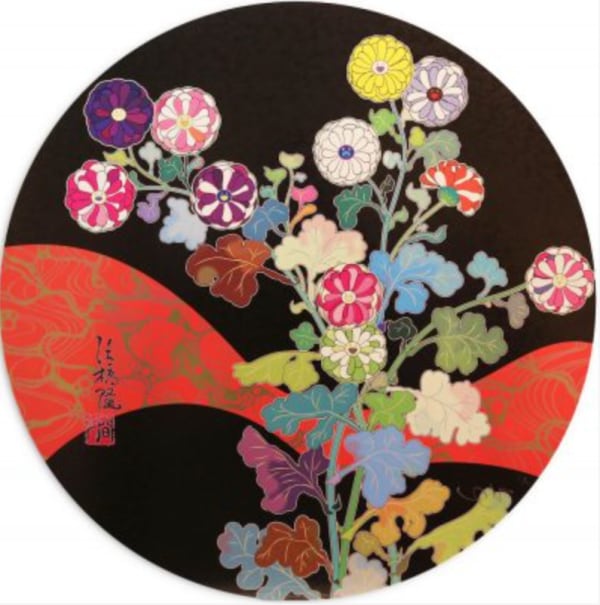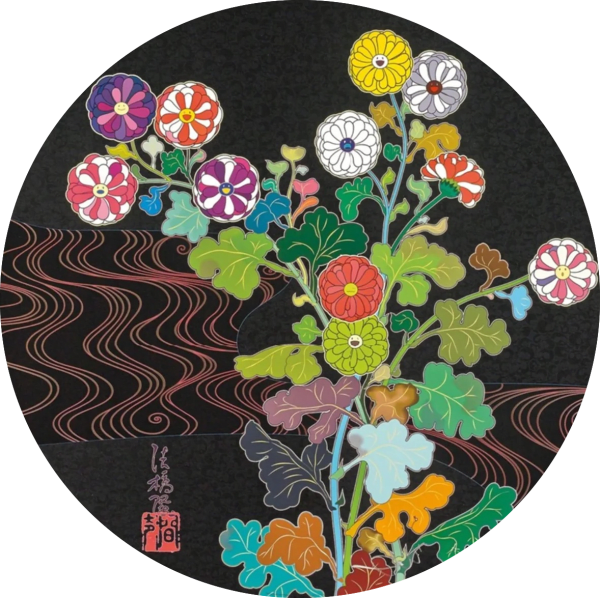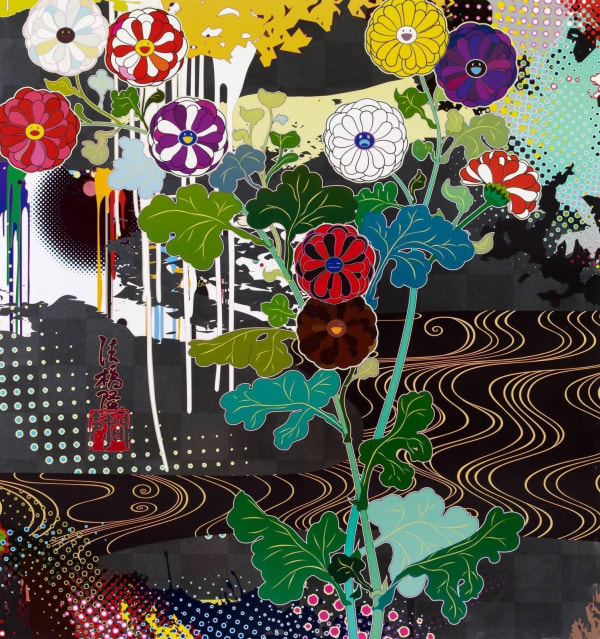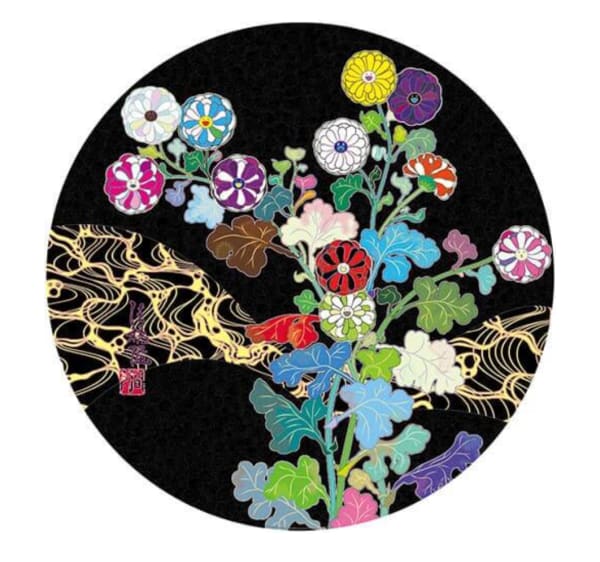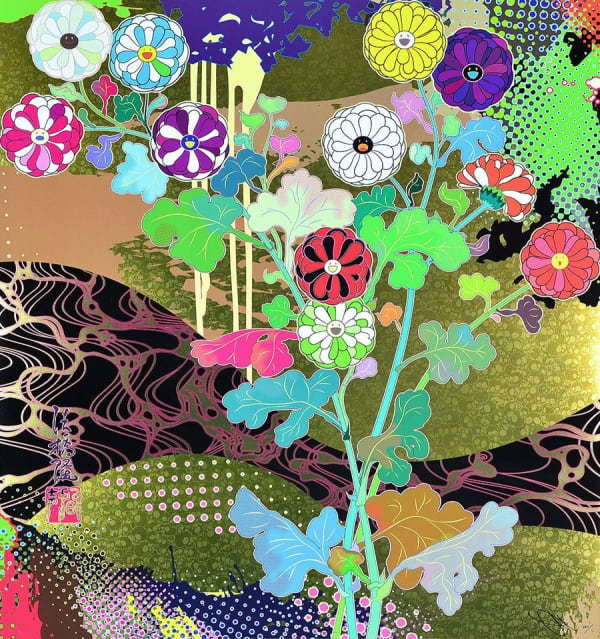
Takashi Murakami
Kansei (trade name of Rinpa- School Edo Painter Ogata Korin), 2010
Offset lithograph, cold stamp and high gloss varnishing
28 x 28 in
71.1 x 71.1 cm
71.1 x 71.1 cm
Edition of 300
Copyright The Artist
Takashi Murakami's Kansei series is a striking collection of lithograph prints produced around 2010, deeply rooted in the Japanese concept of *kansei*, which involves sensing a situation or an artifact...
Takashi Murakami's Kansei series is a striking collection of lithograph prints produced around 2010, deeply rooted in the Japanese concept of *kansei*, which involves sensing a situation or an artifact and forming an individual emotional response. This series exemplifies Murakami's celebrated ability to merge Eastern themes and motifs with Western fine art techniques, creating artworks that are both visually stunning and rich in cultural significance.
The series features a mix of tondos—circular works derived from the Renaissance era—and more traditional rectangular prints, such as *Kansei Platinum*. The use of the tondo format, which harks back to the Italian term *rotondo* meaning round, adds a historical dimension to Murakami's work, connecting the Renaissance focus on form and harmony with contemporary artistic expression.
Central to the Kansei series are the spectacular depictions of chrysanthemums, rendered in bright, vibrant colors against intricately patterned backgrounds. These backgrounds, often embellished with gold and platinum leaves, contribute to a psychedelic aesthetic that enhances the visual impact of the flowers. This choice of motif and style pays homage to the 17th-century Japanese artist Ogata Kōrin, known for his white chrysanthemum motifs, which have evidently influenced Murakami's floral representations.
Unlike some of Murakami’s more pop-culture-driven works, such as the Flower Ball series, the Kansei collection leans more towards a traditional aesthetic, reminiscent of the *nihonga* style of Japanese painting. This traditionalist influence is a nod to Murakami's extensive training at the Tokyo University of Fine Arts and Music, where he not only completed his undergraduate studies but also pursued a Master's and a PhD focusing on traditional Japanese painting techniques.
Murakami's time in New York, marked by his participation in the PS1 International Studio Program in 1994, was pivotal in expanding his artistic horizons. During this period, he was exposed to the works of Western contemporary artists like Anselm Kiefer and Jeff Koons, experiences that enriched his artistic vocabulary and encouraged him to experiment with new styles and media. This blend of Eastern and Western influences is a hallmark of Murakami's work, allowing him to create a unique visual language that resonates with a global audience.
Through the Kansei series, Murakami invites viewers to engage with a fusion of historical reverence and modern innovation, showcasing his mastery in blending diverse artistic traditions and techniques. This collection not only reflects Murakami's roots in traditional Japanese art but also his ongoing dialogue with contemporary art practices, making it a significant contribution to both his oeuvre and to the broader art world.
The series features a mix of tondos—circular works derived from the Renaissance era—and more traditional rectangular prints, such as *Kansei Platinum*. The use of the tondo format, which harks back to the Italian term *rotondo* meaning round, adds a historical dimension to Murakami's work, connecting the Renaissance focus on form and harmony with contemporary artistic expression.
Central to the Kansei series are the spectacular depictions of chrysanthemums, rendered in bright, vibrant colors against intricately patterned backgrounds. These backgrounds, often embellished with gold and platinum leaves, contribute to a psychedelic aesthetic that enhances the visual impact of the flowers. This choice of motif and style pays homage to the 17th-century Japanese artist Ogata Kōrin, known for his white chrysanthemum motifs, which have evidently influenced Murakami's floral representations.
Unlike some of Murakami’s more pop-culture-driven works, such as the Flower Ball series, the Kansei collection leans more towards a traditional aesthetic, reminiscent of the *nihonga* style of Japanese painting. This traditionalist influence is a nod to Murakami's extensive training at the Tokyo University of Fine Arts and Music, where he not only completed his undergraduate studies but also pursued a Master's and a PhD focusing on traditional Japanese painting techniques.
Murakami's time in New York, marked by his participation in the PS1 International Studio Program in 1994, was pivotal in expanding his artistic horizons. During this period, he was exposed to the works of Western contemporary artists like Anselm Kiefer and Jeff Koons, experiences that enriched his artistic vocabulary and encouraged him to experiment with new styles and media. This blend of Eastern and Western influences is a hallmark of Murakami's work, allowing him to create a unique visual language that resonates with a global audience.
Through the Kansei series, Murakami invites viewers to engage with a fusion of historical reverence and modern innovation, showcasing his mastery in blending diverse artistic traditions and techniques. This collection not only reflects Murakami's roots in traditional Japanese art but also his ongoing dialogue with contemporary art practices, making it a significant contribution to both his oeuvre and to the broader art world.
%3Cdiv%20class%3D%22artist%22%3ETakashi%20Murakami%3C/div%3E%3Cdiv%20class%3D%22title_and_year%22%3E%3Cspan%20class%3D%22title_and_year_title%22%3EKansei%20%28trade%20name%20of%20Rinpa-%20School%20Edo%20Painter%20Ogata%20Korin%29%3C/span%3E%2C%20%3Cspan%20class%3D%22title_and_year_year%22%3E2010%3C/span%3E%3C/div%3E%3Cdiv%20class%3D%22medium%22%3EOffset%20lithograph%2C%20cold%20stamp%20and%20high%20gloss%20varnishing%3C/div%3E%3Cdiv%20class%3D%22dimensions%22%3E28%20x%2028%20in%3Cbr/%3E%0A71.1%20x%2071.1%20cm%3C/div%3E%3Cdiv%20class%3D%22edition_details%22%3EEdition%20of%20300%3C/div%3E
Related artworks
-
 Takashi MurakamiKansei: Fresh Blood, 2013
Takashi MurakamiKansei: Fresh Blood, 2013 -
 Takashi MurakamiKansei Korin Red Stream, 2009
Takashi MurakamiKansei Korin Red Stream, 2009 -
 Takashi MurakamiKansei Korin Gold, 2010
Takashi MurakamiKansei Korin Gold, 2010 -
 Takashi MurakamiHokkyo Takashi Kansei: The Golden Age, 2016
Takashi MurakamiHokkyo Takashi Kansei: The Golden Age, 2016 -
 Takashi MurakamiKansei Like The River Flow, 2010
Takashi MurakamiKansei Like The River Flow, 2010 -
 Takashi MurakamiKansei Skulls, 2010
Takashi MurakamiKansei Skulls, 2010 -
 Takashi MurakamiKansei: Voice of the Mountaun Stream, 2007
Takashi MurakamiKansei: Voice of the Mountaun Stream, 2007 -
 Takashi MurakamiKansei Platinum, 2010
Takashi MurakamiKansei Platinum, 2010 -
 Takashi MurakamiThe Golden Age , Korin , Kansei, 2014
Takashi MurakamiThe Golden Age , Korin , Kansei, 2014 -
 Takashi MurakamiKansei: Wildflowers Glowing In The Night, 2014
Takashi MurakamiKansei: Wildflowers Glowing In The Night, 2014 -
 Takashi MurakamiKorin: Dark Matter, 2015
Takashi MurakamiKorin: Dark Matter, 2015 -
 Takashi MurakamiKorin: Azure River, 2015
Takashi MurakamiKorin: Azure River, 2015 -
 Takashi MurakamiKorin: Superstring Theory , 2015
Takashi MurakamiKorin: Superstring Theory , 2015 -
 Takashi MurakamiThe Time Of Celebration, 2015
Takashi MurakamiThe Time Of Celebration, 2015
